Decades of Support for Spill Responses
For significant oil or chemical spills, OR&R is responsible for providing scientific support to the Federal On-Scene Coordinator (FOSC) overseeing the response. Under the National Contingency Plan and the National Response Plan, OR&R works with the U.S. Coast Guard, which is the FOSC for marine spills, while the U.S. Environmental Protection Agency assumes this responsibility for inland spills.
OR&R has provided emergency response for thousands of oil and chemical spills over the years. IncidentNews provides a comprehensive list of spills and other incidents we have supported—but check out this timeline identifying some of the significant incidents we have supported over the decades.
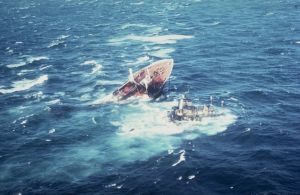
December 15, 1976 | Argo Merchant Oil Spill
The Liberian tanker Argo Merchant went aground on Nantucket Shoals, 29 nautical miles southeast of Nantucket Island, Massachusetts in high winds and 10-foot seas.
Image credit: NOAA
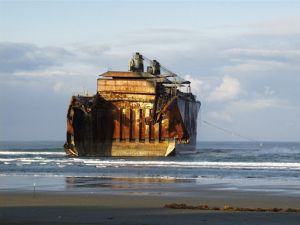
February 4, 1999 | M/V New Carissa
The M/V New Carissa was a freighter that ran aground on a beach near Coos Bay, Oregon during a storm and broke apart.
Image Credit: USCG
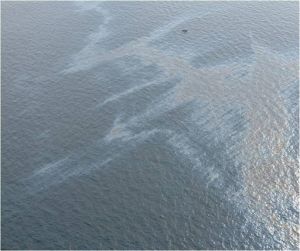
September 16, 2004 | Taylor Energy Platform
This spill occurred in the Gulf of Mexico about 10 miles off the coast of Louisiana. It resulted from the destruction of Taylor Energy’s MC20 oil production platform during Hurricane Ivan in 2004. Continuing for nearly two decades, it has become the longest-running oil spill in U.S. history.
Image Credit: NOAA, Jim Jeansonne
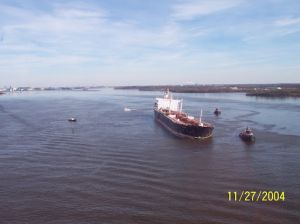
November 26, 2004 | Athos I Oil Spill
While preparing to dock at a refinery outside Philadelphia, the single-hulled tanker Athos I unknowingly struck a large anchor submerged in the Delaware River. The impact punctured the tanker's hull, and it began leaking more than 263,000 gallons of heavy oil into the tidal waters of this busy East Coast shipping route.
Image Credit: NOAA/Ed Levine
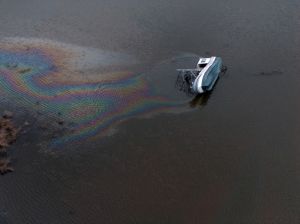
August 29, 2005 | Hurricanes Katrina and Rita
Hurricanes Katrina and Rita made landfall less than a month apart: Katrina striking near the Louisiana-Mississippi border, and Rita slamming into the Louisiana-Texas border. The storms created catastrophic damage along the Gulf Coast.
Image credit: USCG
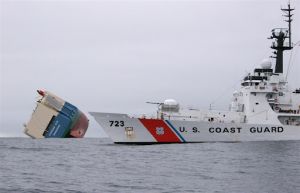
July 23, 2006 | M/V Cougar Ace
The Cougar Ace, a container ship transporting over 4,800 automobiles from Japan to Vancouver, Canada, began to take on water southwest of Atka, Alaska. It listed to its port side and began leaking oil.
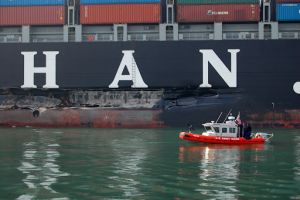
November 7, 2007 | Cosco Busan Oil Spill
The container ship Cosco Busan struck the Bay Bridge in San Francisco, California in heavy fog, resulting in a 100-foot gash in the hull of the vessel and release of 53,000 gallons of diesel into San Francisco Bay.
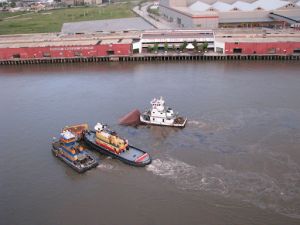
July 23, 2008 | Barge DM932
The chemical tanker Tintomara collided with barge DM932 on the Mississippi River near downtown New Orleans. The Tintomara suffered minor damage, but the DM932 barge split into two sections, spilling 283,000 gallons of fuel oil.
Image credit: USCG
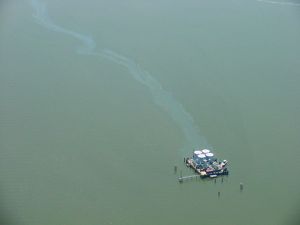
September 1, 2008 | Hurricanes Gustav and Ike
Two hurricanes, Gustav and Ike, struck within a two week period, having serious impacts in Gulf Coast states.
Image credit: LDEQ
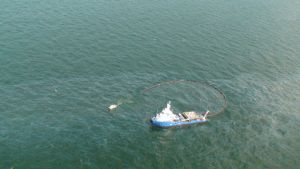
July 26, 2009 | Eugene Island Pipeline Spill
A 20-inch diameter line, which carried Eugene Island grade crude to shore, lost pressure and released oil about 60 miles southwest of Houma, Louisiana, in waters about 60 feet deep.
Image Credit: USFWS
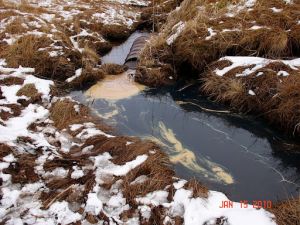
January 11, 2010 | Adak Petroleum Tank Release
Diesel fuel spilled from an underground tank at the Adak Petroleum Bulk Fuel facility on Adak Island in the Aleutian Islands of Alaska. The fuel entered Helmet Creek, a salmon creek that flows into the small boat harbor in the Port of Adak.
Image Credit: NOAA/John Whitney
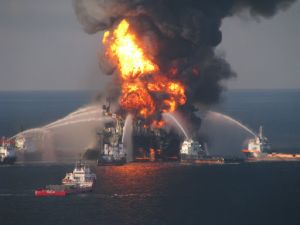
April 20, 2010 | Deepwater Horizon Oil Spill
An explosion on the Deepwater Horizon Macondo oil well drilling platform tragically killed 11 workers, and started the largest marine oil spill in U.S. history, releasing millions of barrels of oil into the Gulf of Mexico.
Image Credit: USCG
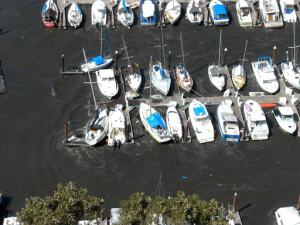
March 11, 2011 | Japan Earthquake and Tsunami
The largest earthquake in Japanese history struck the northeast region of the island nation, creating a tsunami that hit Japan and radiated out into the Pacific.
Image Credit: USCG
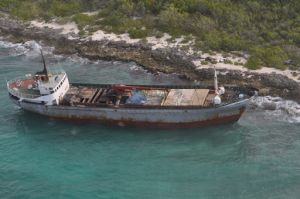
June 21, 2012 | M/V Jireh
The 202-foot M/V Jireh ran aground on Mona Island, a small, uninhabited island 41 miles west of Puerto Rico, crushing and toppling corals as it plowed into the reef.
Image Credit: USCG
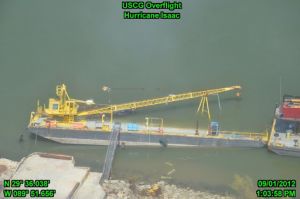
August 28, 2012 | Hurricane Isaac
After Hurricane Isaac's initial landfall, the U.S. Coast Guard received reports of 158 oil spills and 171 objects possibly containing hazardous materials (such as propane tanks and drums with unknown contents) in affected areas of Louisiana.
Image Credit: USCG
August 29, 2021 | Hurricane Ida
Hurricane Ida made landfall as a Category 4 hurricane, leaving behind a path of destruction and leaving over a million people without power along the Louisiana coastline.
Image credit: Louisiana Governor's Office of Homeland Security & Emergency Preparedness/Jim Richard
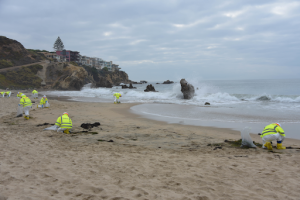
October 1, 2021 | Huntington Beach Oil Spill
An oil pipeline off the coast of Southern California ruptured, oiling shorelines in the Huntington Beach and Newport Beach areas, affecting local wildlife, and forcing beach and fishing closures.
Image Credit: USCG/PO3, Janessa Warschkow
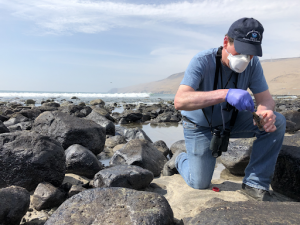
January 15, 2022 | Oil Spill near Lima, Peru
A significant oil spill occurred at the offshore mooring for the La Pampilla crude oil refinery in Lima, Peru. The spill oiled more than 35 miles of shoreline, created a serious health risk at more than 24 beaches, and impacted five marine protected areas.
Image Credit: NOAA/Brandi Todd
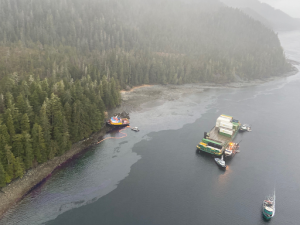
March 21, 2022 | Tug Western Mariner
The tug vessel Western Mariner was towing a freight vessel, headed south in Neva Straight outside of Sitka, when a steering failure onboard the tug caused the barge to collide with it. The collision pushed the tug onto the beach, resulting in the release of diesel.
Image Credit: Alaska Department of Fish and Game
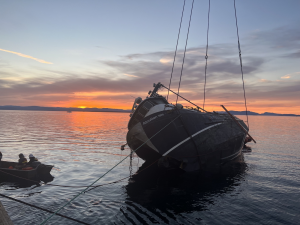
August 13, 2022 | F/V Aleutian Isle
The 58-foot fishing vessel Aleutian Isle sank off San Juan Island in Washington State, with an estimated 2,500 gallons of diesel on board and 100 gallons of engine oil and hydraulic oil. It was recovered from over 250 feet of water on September 17 after weeks of complex dive operations.
Image Credit: USCG
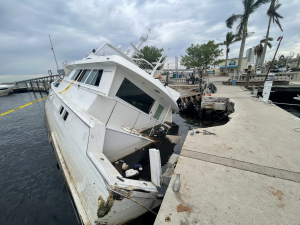
September 19, 2022 | Hurricane Ian
The second major hurricane of the 2022 Atlantic hurricane season, Hurricane Ian was a devastating and powerful Category 4 hurricane that caused widespread damage across the southeast U.S., especially the states of Florida and South Carolina.
Image Credit: NOAA/William Whitmore
 An official website of the United States government.
An official website of the United States government.
